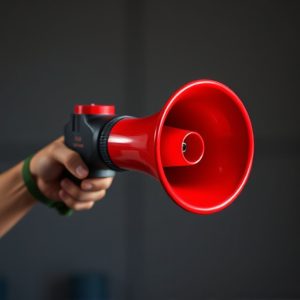Maximizing Safety: A Guide to Air Horn Self-Defense Devices
An air horn self-defense device offers a reliable and effective non-lethal means to deter attackers…….
An air horn self-defense device offers a reliable and effective non-lethal means to deter attackers with its high-decibel alarm, capable of exceeding 120 decibels. Its robust construction ensures durability under stress, making it a dependable choice for personal safety. The device is designed for ease of use, with a simple activation mechanism that allows users to emit a loud blast to disorient assailants and call for help over long distances. It's portable, user-friendly, and can be paired with other personal security measures like pepper spray or personal alarm apps as part of a comprehensive safety strategy. Regular maintenance is key to ensure it functions correctly in critical situations. Air horn self-defense tools are regulated by law, and users must adhere to local noise ordinances to avoid legal issues. Ethical use is also paramount, considering the potential impact on individuals with sensory issues or hearing impairments. In urban environments, air horns can effectively de-escalate confrontations, serving as an auditory and visual shield against threats by disorienting attackers and drawing attention to your location for assistance. They are particularly useful in crowded places where immediate help is necessary, and they provide a viable option for personal protection in a variety of situations without the need for physical combat or traditional weapons.
When personal safety becomes paramount, an effective self-defense tool can be a game-changer. Among the array of options, the air horn self-defense device emerges as a powerful deterrent. This article delves into the transformative role these devices play in protecting individuals from potential threats. We’ll explore their key features, offer guidance on selecting the most suitable model for your safety needs, and address the legal and ethical dimensions of their use. Real-life scenarios will demonstrate their practical efficacy, making a compelling case for considering an air horn self-defense device as part of your personal security strategy.
Understanding the Air Horn Self-Defense Device: A Comprehensive Overview
An air horn self-defense device serves as a potent tool for personal safety, capable of emitting an ear-piercing alarm to deter attackers and attract attention in emergency situations. Its effectiveness lies not solely in its high-decibel sound output but also in its visibility as a deterrent. The robust construction of the device ensures it is reliable under duress, making it a dependable companion for individuals seeking an effective non-lethal self-defense option. Users can activate the air horn with a simple push of a button, releasing a disorienting blast that can incapacitate an assailant temporarily and signal for help over considerable distances. This device is designed to be user-friendly, operable even in high-stress situations, and is an accessible alternative for those who may not feel comfortable using more physical forms of self-defense. Its audible range can often surpass human pain thresholds for sound, offering a formidable defense against threats while ensuring the safety of the user. Additionally, the air horn’s design incorporates features such as a directional sound projection to target the ears of an attacker specifically, maximizing its defensive capabilities without causing permanent harm. It is a critical component of a layered personal security strategy, complementing other measures like pepper spray or a personal alarm app. Understanding the mechanics and proper usage of an air horn self-defense device is crucial for those looking to enhance their personal safety arsenal. Regular maintenance checks and familiarity with local laws governing its use are also important considerations to ensure readiness in critical moments.
Key Features of Personal Alarm Air Horns for Effective Self-Defense
Personal alarm air horns have become an indispensable tool for individuals seeking to enhance their personal safety and self-defense capabilities. These devices are engineered with a blend of high-decibel sound and audible alert systems designed to disorient potential attackers while drawing attention to your location. The air horn itself emits a piercing sound that can reach upwards of 120 decibels, which is not only capable of deterring assailants but also meets the legal threshold for personal alarm devices in many regions.
The effectiveness of these air horn self-defense tools lies in their key features. They are compact and lightweight, allowing users to carry them effortlessly. The simplicity of operation is another critical aspect; with an intuitive design, users can activate the alarm with a quick squeeze or press of a button, ensuring a rapid response when seconds count. Additionally, these devices often come with a combination of an ear-piercing air horn sound and a flashing strobe light, which significantly increases the likelihood of capturing an attacker’s attention and alerting nearby individuals to your predicament. The inclusion of a replaceable battery ensures that the device is ready for use whenever it’s needed. When selecting a personal alarm air horn for self-defense, consider its loudness, durability, ease of use, and reliability in various environmental conditions to ensure you have a dependable companion in potentially dangerous situations.
How to Choose the Right Air Horn Self-Defense Tool for Your Needs
When considering an air horn as a self-defense tool, it’s crucial to evaluate several factors to ensure it effectively meets your personal safety needs. Firstly, the decibel level of the air horn is paramount; a high-decibel sound can deter potential assailants by emitting a loud, disorienting noise that draws attention. Look for an air horn self-defense tool with a minimum sound output of 120 decibels or higher, as this is often recommended for its effectiveness in public settings.
Next, the ease of use and accessibility of the air horn should be taken into account. In stressful situations, fumbling for a complicated device can be detrimental. Opt for an intuitive design that allows for quick deployment and operation with minimal effort. Additionally, the visibility of the air horn during both daylight and dark conditions is important. Consider models with bright flashlights or those that are high-visibility colors to ensure it’s noticeable when needed. Other practical considerations include the size and weight of the air horn, as you’ll want something portable and not cumbersome to carry regularly. Lastly, reviewing the maintenance requirements of your chosen air horn self-defense tool will help ensure its reliability in an emergency. Regular checks for proper function and refilling of CO2 cartridges, as required, will guarantee that it is ready for use whenever protection is necessary.
The Legalities and Ethical Considerations of Using an Air Horn Self-Defense Device
When considering the adoption of an air horn as a self-defense mechanism, it’s crucial to navigate the intersection of legal statutes and ethical considerations. The air horn self-defense device is explicitly designed to emit a loud, piercing sound capable of disorienting an attacker or drawing attention to an incident. In many jurisdictions, the use of such devices is regulated, often with specific noise limitations to prevent misuse. Users must be aware of local ordinances that govern the decibel levels allowed in public spaces and ensure their device complies with these regulations to avoid legal repercussions.
Ethically, the use of an air horn for self-defense raises important questions about personal safety, community noise standards, and the potential impact on individuals with sensory sensitivities or those who are hard of hearing. Users should consider the immediate environment and the potential harm a high-decibel alarm could cause to bystanders or those nearby. The ethical use of an air horn in self-defense involves a careful balance between protecting one’s safety and respecting the rights and well-being of others. It is imperative for users to handle such devices responsibly, using them only when there is an imminent threat and as a last resort. Understanding the legal framework and ethical implications ensures that the use of air horn self-defense devices remains a viable option for personal safety within societal norms.
Real-Life Scenarios: The Efficacy of Air Horn Self-Defense in Various Situations
In a multitude of scenarios, an air horn self-defense mechanism has proven to be a highly effective tool for personal safety. Its piercingly loud siren can disorient and deter potential threats, serving as a powerful auditory barrier between an individual and harm. For instance, in situations where one is confronted by an aggressive animal or an unpredictable person, the immediate and disconcerting sound of an air horn can be a critical factor in de-escalating the confrontation. The high decibel output not only signals for help but also indicates to assailants that their actions have been recognized and that authorities may soon be alerted. Furthermore, its use is often accompanied by a visual shock factor, as the bright light on some models can further disorient an attacker, making it a versatile self-defense option for a wide range of potentially threatening environments.
The efficacy of air horn self-defense is not limited to outdoor or rural settings; it is equally applicable in urban environments where space and situational awareness are at a premium. In crowded areas such as parking lots, public transport stations, or city streets, an air horn’s audible range can cut through ambient noise, ensuring that one’s distress signal cannot be ignored. Its ability to quickly attract attention from bystanders or security personnel is invaluable, especially when physical confrontation might lead to injury or escalate the situation. Additionally, its non-lethal nature means that it is a defensible option for those who are not trained in martial arts or do not carry traditional weapons. The psychological impact of an air horn’s alarm can be a significant deterrent, often allowing individuals to escape dangerous situations and reach safety.


